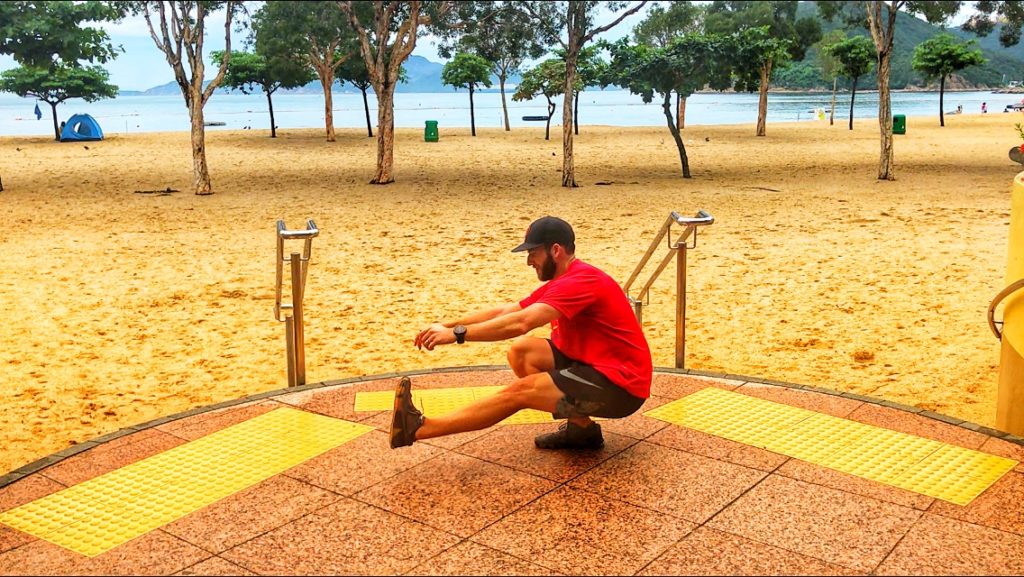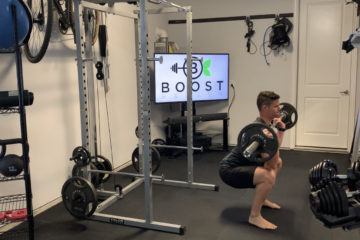
This is another post where there was so much great content in the podcast it was difficult to capture in blog form. I suggest listening to the show in your favourite podcast app below to get the full experience. Below are notes of what we covered in the third and final part in this awesome series on mobility.
I have a special guest with me today, Mr. Joel Lieginger. He is a very good friend of mine whom I met through the SIRs cycling club here in Hong Kong.
I asked Joel to be on the show today because he has a lot of experience and perspective in a fitness discipline I have become obsessed with lately. I think adding in this discipline is a tremendous opportunity to improve my health and fitness. Before we dig into what this new obsession of mine is, I want to tell you a little bit about Joel.
Joel has lived in Hong Kong with his wife Emily and three kids Charlie, Eleanor, and Elizabeth, for the past 8 years. He works at a little company called AIA, that for those of you listening from other parts of the world, is the largest insurance company across Asia, and he has been with AIA, in numerous roles, for his full time in HK, and currently runs their third party distribution platform.
As for a little more on Joel’s personal background before we get into the show, Joel’s athletic background covers team and individual sports, and both organized and outdoor activities. He grew up as many of us did playing numerous sports, and his include swimming competitively, baseball, soccer, tennis, football, rugby, and ice hockey. He then spent 10 years doing triathlon and was a solid age group competitor in the US, before having kids and stepping back from the sport. And more recently he’s a keen cyclist and cross fitter, to keep himself tuned up for his real passions of skiing in the winter.
As you know by now, the theme of this blog and podcast is to try new wellness tactics and see what sticks for YOU. It is a personal journey as we all respond differently to different stimuli. Somehow along my wellness journey I had not truly discovered mobility. I have danced all around it with disciplines such as dynamic warm up, foam rolling and smashing, yoga, ELDOA, and flexibility training. These can assist with mobility but they aren’t really a dedicated mobility program. What do I mean? Isn’t flexibility, mobility? No.
Let me explain with an example. A couple months ago I did a cycling race put on by the Dragons Triathlon club here in Hong Kong.
Pistol Squat Discovery
It was a 4 man time trial race across 48km and our team was comprised of my buddies Joel, Ric, Tom, and myself. We worked hard and put in a good effort on the course. Afterward we were having coffee and the topic of functional fitness and mobility came up. Joel decided to perform a pistol squat in reference to mobility. He executed a perfect pistol squat, shortly after completing a gruelling race mind you, and we were very impressed. If you are not familiar with a pistol squat, it is regarded by many as one of the best exercises to showcase fitness ability. In the most basic terms, you are completing a squat on one leg while extending the opposite leg straight out in front of the body.
You can see a beautifully executed pistol squat here by calisthenics expert and Certified Strength and Conditioning Specialist, Al Kavadlo. The reason it is highly regarded, is also the same reason a pistol squat should be slowly worked up to. Also, as promised, here is Joel doing his technically sound pistol.
For those of you who follow me know I designed a pretty well-rounded fitness program for myself. I do full body strength training 3 times per week, cycling, swimming, running, dynamic warmups before all workouts and sports, and cool downs with stretching. Within these disciplines I would say I am quite strong when looking at classic movements like squats, presses, and deadlifts. I would also say I am quite flexible if you look at standards like the seat and reach. But, with all of this training and ability, I was not able to even come close to performing the pistol squat correctly. Why? The answer, as I have come to learn, is my lack of mobility.
Mobility Is Not Flexibility
There is a great article on the shape.com website that goes into the difference between mobility and flexibility. Fellow Certified Strength and Conditioning Specialist (CSCS), Grayson Wickham, very nicely describes flexibility as the temporary elongating of your connective tissue, and mobility, as moving muscles under control through range of motion in the joint socket. He suggests that flexibility, body awareness, strength, and coordination are all components of mobility.
This is a brilliant way to think of mobility and also quite intuitive. For example you may have very good body awareness and flexibility, but if you don’t have enough strength and coordination in your hips and glute muscles, then you may not be able to properly perform a proper squat.
Joel can you tell us the story of how you got interested in mobility work?
I heard you once say that mobility work “changed your life”. How so?
Mobility, Fix Me Please
I don’t like to not be good at something, especially in the fitness arena. In addition to my renewed interest and understanding of mobility I have been inspired to take new action as I have struggled with a knee injury this year. My osteopath feels it may be a tracking issue. It is something I haven’t been able to shake for a few months now. The knee only hurts when I run. Luckily I can do strength training, mobility work, swimming, and biking, all without issue. My hope is that this additional mobility training will help with some apparent imbalances. Perhaps improving mobility in the hips, ankles, calves, and back, can provide me the ability to run on the knee again pain free. I will keep you posted on that.
Do you recall having a period of soreness in back, hips, anywhere when you first got started?
Did you have any issues with lack of mobility in your ankles when you first got started?
It Might Be Your Ankles, Not Your Hips
Dr. John Rusin has a nice little video series and article on the t-nation website that goes through a screening for ankle mobility and strategies to assist in improving yours if needed.
It appears that I failed ankle mobility and this is likely why I can’t do a pistol yet or get super comfortable at the bottom of a squat hold. We are one big kinetic chain and a kink in the chain can ruin the system. Or as Kelly Starrett would say is it a “system of systems” causing the issue. Starrett is well known and respected physical therapist and mobility guru who has an excellent online tool for improving mobility called MobilityWOD which is short for Mobility Workout Of the Day. This is a highly trusted and valued resource as more and more people are starting to see the benefits of daily mobility work.
I know you are big into strength training, cycling, and baseball. Has mobility work helped your performance in these sports?
Do you think mobility work has helped you avoid injuries?
Research
It seems the best way to show the effectiveness of mobility is through the research that has been done with functional movement screening (FMS), which was developed by Gray Cook and team in 1997. According to a 2014 study in the International Journal of Sports Physical Therapy, the FMS includes 7 fundamental movement pattern tests including Deep Squat, Hurdle Step, Line Lunge, Shoulder Mobility, the Active Straight Leg Raise, the Trunk Stability Push‐up, and Rotary Stability. During these tests a wooden dowel is used overhead, along these spine, across the shoulders, etc. to help asses mobility throughout the body. One example is in the deep squat where the dowel is held overhead. The technician will evaluate if the dowel is being held overhead in line with the participant’s feet and if the dowel is parallel to the floor. This is a fabulous way to test mobility all throughout the body including the ankles, hips, thoracic spine, shoulders, and core.
A 2009 study in the Scandinavian Journal of Medicine and Science in Sports found that interventions of mobility training in the off-season for NFL football players helped improve or maintain their mobility. This is based on the aforementioned Functional Movement Screening (FMS) at the beginning and end of the off-season for these players. There was even some evidence of reduced risk of injury for the players but more research needed to be completed to be definitive.
Are Pistol Squats Safe?
There is some concern over the safety of pistol squat. I think this mostly likely due some folks perhaps advancing into the movement too quickly. Seems like it takes time to master.
Do you recall how long it took before you could perform the pistol correctly and if there were ever any injuries you suffered in attempting them?
In an article on the bodybuilding.com website, the aforementioned Al Kavadlo, discuss how critics of the pistol squats worry about rounding of the back that is required but he notes that the body is not loaded with additional weight on the movement and feels it is safe to complete if progressed into slowly. He offers a few progression options to master before attempting the real thing.
How was your mom was a fitness mentor for you, especially for mobility?
Describe the brain unlocking and letting go process
The Next Big Thing?
I get most excited to go to the gym when I am going to try something new. I am always curious if new exercises, equipment, techniques, apparel, music, etc. will help me unlock something new with my body. What if I never tried full body strength training or plant-based? Is mobility work that next big thing for me? In just a few days of focused mobility work I am already feeling stronger in my squats. I think this could be a big one.
Is there something you are checking out right now in the wellness space that has you fired up?
How do you find your wellness balance?
Podcast: Play in new window | Download
Subscribe Apple Podcasts | Google Podcasts | RSS







